It’s Easier Than You Think
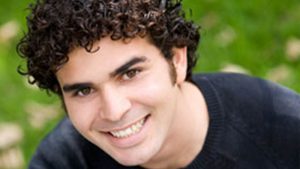 We are dedicated to meeting your orthodontic needs in a warm, friendly atmosphere. We create awesome smiles for our patients by:
We are dedicated to meeting your orthodontic needs in a warm, friendly atmosphere. We create awesome smiles for our patients by:
- Producing results quickly. Utilizing the best technologies, we create your optimal smile in months not years, often without extracting teeth.
- Respecting your time. Our methods require fewer adjustments, resulting in fewer visits. We know you’re busy. That’s why we created a unique scheduling system to keep us on track and get you on your way faster.
- Believing in continuing education. Dr. Tom has dedicated his life to being the best in his field. He is a Board Certified Orthodontist and a preferred provider for both the Damon® System and Invisalign®.
- Striving to be the best. Dr. Tom has repeatedly been recognized as one of the top orthodontists in the Delaware Valley, by both patients and peers.
Am I ready for Braces?
 There are several key things you can look for to determine if you should consider an orthodontic evaluation. Naturally, your family dentist is the best source to recommend pursuing orthodontic treatment. For adult patients technology and innovation have made braces less noticeable and more comfortable than ever before. And at Kadar Orthodontics, we use the latest technology to make it fast too, in most cases in less than 14 months! For baby boomers, a bright, healthy smile keeps us feeling younger, looking good and contributes to our general health as we grow older.
There are several key things you can look for to determine if you should consider an orthodontic evaluation. Naturally, your family dentist is the best source to recommend pursuing orthodontic treatment. For adult patients technology and innovation have made braces less noticeable and more comfortable than ever before. And at Kadar Orthodontics, we use the latest technology to make it fast too, in most cases in less than 14 months! For baby boomers, a bright, healthy smile keeps us feeling younger, looking good and contributes to our general health as we grow older.
But orthodontics is more than just straightening teeth. For a bite to be stable the teeth have to fit together in the correct way, so that you have a healthy bite and balanced face.
Our goal is to make treatment time as short as possible while also achieving the absolute best results.
The approach is similar in children and teenagers. Here are some other ways you can notice early problems with your child’s teeth:
Look for excess spacing and crowding. If large gaps are present or overlapping teeth become obvious, orthodontic correction is necessary.
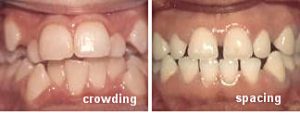
Teeth that are missing or erupt incorrectly function improperly and look less pleasing.
Improper bite. Have your child close his or her teeth, and see if the upper front teeth stick out or protrude when compared to the lower teeth. If the upper teeth bite behind the lower teeth (underbite), you should also consider treatment.


Check for symmetry by comparing the middle of the upper teeth to the middle of the lower teeth.
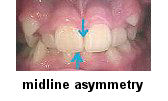
Any of these problems can cause functional and developmental deficiencies.
The advantages of an early start
We evaluated one 7-year old with a severe underbite. By guiding the formation of her lower jaw, and by correcting her crossbite, we developed a better position for her emerging permanent teeth. When she reached adolescence, she simply wore braces, which straightened her teeth and made her a happy, health and very attractive teenager.
How early should you begin?
Seven could be your child’s lucky number!
That’s because the American Association of Orthodontists recommends all children receive their first orthodontic screening around the age of seven. And we agree. This allows us to evaluate the child early, to determine whether orthodontic treatment may be required.
Very often, the Doctor’s recommendation is “let’s wait and see” until more permanent teeth are in place. Sometimes, we’ll advise what we call the Observation Period, during which we can track changes that take place and get a better picture of the need, if any, for treatment.
If treatment is needed, we can advise the family on the best time for the child to begin. Sometimes, we can begin to correct any abnormalities while the teeth and jaws are still in their formative stages. Some of these problems include:
- Crossbites, causing the lower jaw to shift.
- Severe jaw imbalances.
- Excessive space, due to the early loss of baby teeth.
- Excessive crowding of teeth.
- Airway and speech problems.
 Most Kadar patients will begin orthodontic treatment between ages 11 and 14, when permanent teeth are in place. However, by bringing your child in for an early evaluation, you may be able to avoid costly or arduous treatments later in life. There are several advantages to waiting for the permanent teeth to come in including:
Most Kadar patients will begin orthodontic treatment between ages 11 and 14, when permanent teeth are in place. However, by bringing your child in for an early evaluation, you may be able to avoid costly or arduous treatments later in life. There are several advantages to waiting for the permanent teeth to come in including:
- Fewer appointments will be necessary, so the child spends less time in braces.
- Shorter treatment time means less chance of enamel decalcification and root shortening. There’s less chance of missing school or broken braces, too!
- Your child will be more mature, with a better understanding of the need for braces.
- We encourage you to take a proactive approach to your child’s smile, which is a vital asset for both self-confidence and self-esteem.
The role of your family dentist
Your family dentist will be a key player who can determine the need for an orthodontic specialist.
After an orthodontic evaluation, both your dentist and our doctor will chart a plan for the best result. Orthodontic treatment should not begin until your dentist has evaluated the health of the teeth and gums.
If major dental work is needed, orthodontic treatment will wait until after the dental problems have been resolved. However, some cases will warrant orthodontic care prior to the dentist’s care in order to complete a particular treatment successfully.
When managing a complicated procedure, the orthodontist and dentist will remain in contact with each other throughout the active tooth movement phase. We always recommend that our patients continue to see their family dentist at their regularly scheduled times.
If a tooth requires a filling or any dental attention, that will take priority over our orthodontic treatment. The family dentist will continue to perform all cleanings, checkups and fillings during orthodontic treatment.
Our goal is to provide the best orthodontic care and results so patients can resume their regular routine.
Habits
There are a number of oral habits which can impede progress during the course of orthodontic treatment. Most common habits include thumb and lip sucking, tongue thrusting, nail or cheek biting, grinding, lip chewing, ice chewing and pen/pencil biting.
Teeth move or respond to these types of pressure and may move in undesired directions. Therefore, it is essential to determine if any of these habits exist.
Thumb Sucking
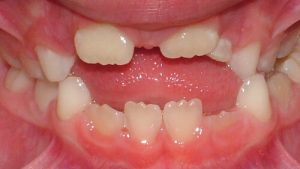 For example, in the case of thumb sucking, the thumb rests on top of the lower front teeth and pushes them back towards the tongue. Additionally, the thumb rests inside the upper teeth and pushes them forward in a flared position. An extremely protrusive appearance is the result of this habit. If the habit can be broken, the teeth will spontaneously resume a more normal direction. Dr. Kadar often recommends for families to visit www.thumbguard.net for more information on thumb sucking habits.
For example, in the case of thumb sucking, the thumb rests on top of the lower front teeth and pushes them back towards the tongue. Additionally, the thumb rests inside the upper teeth and pushes them forward in a flared position. An extremely protrusive appearance is the result of this habit. If the habit can be broken, the teeth will spontaneously resume a more normal direction. Dr. Kadar often recommends for families to visit www.thumbguard.net for more information on thumb sucking habits.
We use many methods to control habits. Appliances, positive reinforcement and speech therapy can be effective. However, the most effective preventive method is for the patient to be ready and willing to stop. We have an excellent rate of success with patients who truly want to control their habit. Please discuss any concerns about oral habits that you or your child may exhibit.
Tongue thrusting
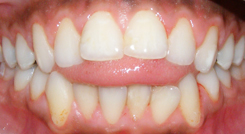 Did you know that you swallow about 2,000 times each day?
Did you know that you swallow about 2,000 times each day?
During each swallow, your tongue can exert about six pounds of pressure on the surrounding teeth! This can push the teeth and bone forward, or move them apart.
Tongue thrusting is a habit that exaggerates the swallowing motion, and can be corrected by training the tongue to sit in the right position. Be patient – it can take about 12 weeks to change this habit.
- Your tongue should sit just behind the row of “bumps” on the roof of your mouth. Being aware of its proper placement can help you retrain your tongue.
- If you need help, a speech language therapist can help you with your exercises.
- It’s important to exercise as often as possible.
Initial Consultation –
Becoming a New Patient
We invite you to visit our office for a complimentary initial consultation. For adults or children, the New Patient Appointment is easy, fun and informative! First, we schedule a convenient appointment time for you, our Doctor and our Treatment Coordinator (a certified and registered dental assistant with specialized training). Our welcome packet (the famous Blue Folder!) will arrive in your mailbox shortly before the scheduled first appointment.
We ask you to complete the folder’s contents including the medical history form, demographic information and “Tell Us About Yourself” form (for kids and teens). To help make your first visit comfortable, you will receive two reminder calls from our office . One will be our automated system so you get the chance to see our technology in action! Secondly, our Treatment Coordinator will call to confirm your appointment personally and answer any last minute questions you may have about the first visit. We ask that you return the favor and confirm one of these two calls so we can be prepared for your appointment.
During the new patient appointment, Team Kadar will provide all of the information you need to make an informed decision about orthodontic treatment including:
- If orthodontics is indicated
- When you can get started
- What type of treatment is needed
- Estimated length of treatment
- Orthodontic insurance and financing options.
When you arrive, the Kadar administrative Team will greet you, review your Blue Folder and help you sign in on our computer! Your Treatment Coordinator will begin the visit with a tour of our office including the computerized check-in, clinic areas and digital imaging room. The digital imaging room is the patient’s first stop. One of our certified and registered dental assistants will take a digital panoramic x-ray of your teeth and have you pose for digital orthodontic pictures.
After this brief stop, we invite you relax in our consultation room while our Doctor examines your teeth, reviews the x-ray and photos and answers your questions about braces. If they feel you are ready for orthodontic treatment, they may suggest that we make a digital model of your teeth. Our Treatment Coordinator is available during this entire visit to guide you through the process. She is even able to explain how your insurance and payment plans can be structured to fit your personal budget and plans.
Not Ready for Braces – What Happened During Wait and See?
When observation is indicated.
The purpose of the Observation period is to monitor your child over the next few years to determine if more active treatment will be needed.
You’ll be asked to return every 3 to 12 months, so that we can track any changes that occur. Don’t worry; you are still a part of the Kadar family even though you don’t have braces! Be sure to watch your mail for the Kadar News, our customized newsletter, that will keep you informed of ongoing orthodontic news, Kadar community events and our current contests. And you can always check this website for the latest Kadar Smiles!
When treatment is recommended.
If, during the Observation Period, we find indications that active treatment may be necessary, we’ll schedule a Diagnostic Records Appointment with you and your child. This 30 minute meeting will include:
- Digital photographs
- Digital panoramic and cephalometric x-rays
- Digital Study models
DIAGNOSTIC RECORDS (Photos, Models & Xrays)
Diagnostic Records are just that – records (or information) that helps Dr. Kadar “diagnose” your specific orthodontic situation. These are taken either at the initial appointment or when Dr. Kadar needs additional information about how your teeth are developing. The Diagnostic records have three parts:
- Digital Photographs – We call these our orthodontic “glamour shots” because we get to see you smile from many different angles. These help Dr. Kadar examine your bite and facial profile. You’ll even get to take a copy home for the old scrapbook!
- Digital Study Models -We are excited to be one of the first offices in our area to offer digital imaging! We can take a digital scan of the mouth and eliminate the need for a gooey impression in most cases! Back when Dr. Kadar had braces, at age 13, he had to endure a gooey, flavorless substance that took 5 minutes to set up in the mouth!! He is excited that his patients don’t have to deal with that! Our new technology offers the most accurate and easily shared study model available. In rare cases, if an actual stone model is necessary,don’t worry, we have almost two dozen flavors of putty-gel material that sets up in 45 seconds!
- Digital X-rays – We have reached the 21st Century! The last part of Diagnostic Records is x-rays – For Orthodontics, we need two x-rays – a panoramic (full mouth) and a Cephalometric (facial profile). To provide the most advanced patient care, Kadar Orthodontics has installed a completely digital x-ray system. This technology is the most precise imaging system available and benefits our patients in many ways. The images can be enhanced, duplicated and diagnosed better than ever. Radiation exposure is cut as much as 90%. With traditional x-rays, the films cannot be enhanced and run the risk of becoming damaged or lost. A chair-side reading allows our patients to see exactly what Dr. Kadar sees and shortens the time for your orthodontic checkup. Your general dentist can also be more actively involved because he/she can retrieve your digital x-rays from our secure server. Best of all, digital x-rays have eliminated the use of harmful chemicals used in developing tanks and we no longer deal with caustic or environmentally damaging solutions. We know you’ll appreciate the difference with our new digital system.
Our doctors will review the diagnostic records after the appointment, and design your individual treatment plan. Within a couple of weeks, you will have a telephone consultation with our Treatment Coordinator to review the findings. You will receive an automated reminder call to confirm this appointment. This is important, because at Kadar Orthodontics, our appointments are tailored to your needs, and even one missed appointment can affect everyone else’s schedule. This meeting or phone call will cover:
- Any appliances you may need to wear
- Your ongoing, personalized appointment schedule
- Fees and any other concerns
Just like our initial consultation, Observation, Diagnostic Records & Consultation appointments are complimentary and scheduled with your busy life in mind! We believe this serves as our commitment to provide you with the best orthodontic treatment and care.
My Braces & Orthodontic Appliances
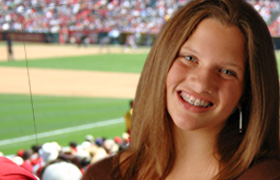 You have your braces on – NOW WHAT! You get to sit back and watch the magic of the Damon System™ But, you do have to follow the instructions that were given to you by Dr. Kadar and our orthodontic assistants. Mainly, you need to be careful about the food you eat, brush regularly and see your family dentist at regular intervals. You can still participate in athletic activities, play musical instruments and of course, Do Homework! Other common areas of concern during orthodontic treatment are summarized below:
You have your braces on – NOW WHAT! You get to sit back and watch the magic of the Damon System™ But, you do have to follow the instructions that were given to you by Dr. Kadar and our orthodontic assistants. Mainly, you need to be careful about the food you eat, brush regularly and see your family dentist at regular intervals. You can still participate in athletic activities, play musical instruments and of course, Do Homework! Other common areas of concern during orthodontic treatment are summarized below:Oral Hygiene with Oral B Ortho Essentials
Taking care of your oral health is a whole different story when you’ve got braces. That’s why Kadar Orthodontics has teamed up with Crest and Oral-B to create OrthoEssentials, a program that can help our patients with braces stay on track with keeping a clean and healthy mouth. With the help of OrthoEssentials, you can steer clear of common problems like gingivitis, tartar, and demineralization, which can result in additional time and expense—and get the most beautiful and healthy smile possible. OrthoEssentials puts together everything a kid (or adult) with braces needs in one convenient kit. It combines the PRO-HEALTH SYSTEM—an ideal collection of oral care products for a someone with braces—with simple educational tools that show patients what their goals are, how easy it is to achieve them, and how to keep tabs on their progress along the way. To understand more about the program, watch this four-minute video about how to use the system.Braces and Candy
When you wear braces, there are certain candies that could haunt you after Halloween is over. If it’s sticky, chewy, hard or crunchy, it is a food that anyone wearing braces or retainers should avoid. The real bad guys are caramel, gum and taffy. You should also stay away from peanuts, taco chips and frozen candies. On the other hand, plain chocolate candy, peanut butter cups, Oreo cookies, fruit pies and ice cream are all A-OK! Candy lovers who gobble up sugary treats should always remember to brush their teeth thoroughly afterwards.Music and Braces
 Patients who play musical instruments often put off orthodontic treatment for fear of missing a beat! You can wear braces and still play an instrument – but it may take a bit of adjustment. When Dr. Kadar got his braces, he played the trumpet. He says, “at first, that my lips would tire quicker and the sound was slightly different. However, after three or four weeks, my playing returned to normal. Most of my musician patients say it takes about a month to get used to playing their instruments with braces. It seems to take longer to adjust if you play a brass instrument.” Should irritation occur while playing an instrument, ask us for some extra wax. That should take care of any problem. However, if the wax doesn’t help, there are special lip bumpers that can be used to ease any pressure. The bottom line is: You can work through it by practicing normally and consistently – and by asking your music instructor to be a little patient with you. Of course, there’s no worry at all if you play the piano!
Patients who play musical instruments often put off orthodontic treatment for fear of missing a beat! You can wear braces and still play an instrument – but it may take a bit of adjustment. When Dr. Kadar got his braces, he played the trumpet. He says, “at first, that my lips would tire quicker and the sound was slightly different. However, after three or four weeks, my playing returned to normal. Most of my musician patients say it takes about a month to get used to playing their instruments with braces. It seems to take longer to adjust if you play a brass instrument.” Should irritation occur while playing an instrument, ask us for some extra wax. That should take care of any problem. However, if the wax doesn’t help, there are special lip bumpers that can be used to ease any pressure. The bottom line is: You can work through it by practicing normally and consistently – and by asking your music instructor to be a little patient with you. Of course, there’s no worry at all if you play the piano!White Spots
Perhaps you’ve noticed that some people who wear braces develop white spots on their teeth. Basically, the discoloration indicates decay due to improper cleaning.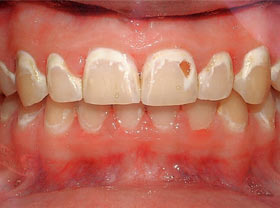 According to recent scientific studies, the depth of this type of tooth decay can be reduced by rinsing with sodium fluoride. It is recommended that patients with fixed braces rinse daily with a .05% solution of sodium fluoride. Of course, the best prevention is to keep teeth meticulously clean through a combination of tooth brushing, flossing and proxy brushes. At Kadar Orthodontics, our goal is to complete a treatment program with bright health teeth and gums – and a great smile. However, this can be achieved only if the patient makes a concerted effort for daily care and has teeth cleaned professionally on a regular basis. Ultimately, it is the patient’s responsibility to follow our instructions on how to clean and maintain teeth and braces – information that we provide on the day braces are put in place. We encourage all patients to ask for help if, at any time, they need assistance with cleaning.
According to recent scientific studies, the depth of this type of tooth decay can be reduced by rinsing with sodium fluoride. It is recommended that patients with fixed braces rinse daily with a .05% solution of sodium fluoride. Of course, the best prevention is to keep teeth meticulously clean through a combination of tooth brushing, flossing and proxy brushes. At Kadar Orthodontics, our goal is to complete a treatment program with bright health teeth and gums – and a great smile. However, this can be achieved only if the patient makes a concerted effort for daily care and has teeth cleaned professionally on a regular basis. Ultimately, it is the patient’s responsibility to follow our instructions on how to clean and maintain teeth and braces – information that we provide on the day braces are put in place. We encourage all patients to ask for help if, at any time, they need assistance with cleaning.Remember: when white spots do occur on teeth following orthodontic treatment; it’s not because the patient is wearing braces. The spots occur as a result of poor hygiene. Keep brushing! Keep smiling!
Orthodontic Appliances
Not so very long ago, orthodontic patients wore braces. Just braces. Now patients wear a variety of appliances with familiar names such as headgear and retainers. Others names not so familiar include Mara, Herbst and bionators. The list is endless, but the appliances have one singular goal: to provide you with straight, healthy teeth. The appliances we use are customized, highly technical devices that allow us to achieve the very best results in the most efficient manner. Unfortunately, many of us have unfavorable jaw and tooth growth. The further from the ideal, the more complicated the treatment! And the appliance! Orthodontists can make these corrections with new and innovative appliances. In more severe cases, the skills of an oral surgeon may be required in the treatment. When you see someone wearing an unusual looking appliance, know that a great effort is being made to improve his/her health and appearance. Patients who persevere through the very difficult treatment programs are to be applauded for their efforts. Adjustment to the more unusual appliances can be difficult. Soon, they will be feeling and looking great! We have listed the most common appliances Dr. Kadar uses and instructions for care of these appliances:
The list is endless, but the appliances have one singular goal: to provide you with straight, healthy teeth. The appliances we use are customized, highly technical devices that allow us to achieve the very best results in the most efficient manner. Unfortunately, many of us have unfavorable jaw and tooth growth. The further from the ideal, the more complicated the treatment! And the appliance! Orthodontists can make these corrections with new and innovative appliances. In more severe cases, the skills of an oral surgeon may be required in the treatment. When you see someone wearing an unusual looking appliance, know that a great effort is being made to improve his/her health and appearance. Patients who persevere through the very difficult treatment programs are to be applauded for their efforts. Adjustment to the more unusual appliances can be difficult. Soon, they will be feeling and looking great! We have listed the most common appliances Dr. Kadar uses and instructions for care of these appliances:Elastics and rubber bands
The use of elastics and rubber bands is an essential part of your treatment. To be effective, they must be worn as directed by Dr. Kadar. Here are some hints to make your treatment more successful:- Wear rubber bands 24 hours every day. There will be absolutely NO progress if you don’t wear them. Part time usage will not move teeth, and as a result, your treatment will take longer.
- Take the rubber bands off only when you brush your teeth.
- Change your rubber bands once a day.
- If you lose your rubber bands, or run out, call our office immediately and tell us the brand name. We’ll either send them right out to you, or have them ready at the office.
Mandibular Anterior Repositioning Appliance (MARA)
.jpg) This is a bite advancer that corrects your overbite or overjet in the most predictable and efficient manner. It replaces the need for headgear or a bulky retainer, and will remain in your mouth for at least 1 year. The MARA can reduce the duration of treatment while achieving optimal results. Initially, it will feel awkward when you hold your jaw forward while eating. Your teeth will not fit together well, and you won’t be able to chew perfectly. But the improvements will be noticeable eventually. In fact, holding your jaw forward makes you look much better! Caring for your MARA appliance: The arms of the MARA are only guides to show you where to bite. Do NOT bang or chew on them, or they will come loose. If the arms lock (a rare occurrence), simply give them a few gentle movements to unlock them and restore them to their proper position.
This is a bite advancer that corrects your overbite or overjet in the most predictable and efficient manner. It replaces the need for headgear or a bulky retainer, and will remain in your mouth for at least 1 year. The MARA can reduce the duration of treatment while achieving optimal results. Initially, it will feel awkward when you hold your jaw forward while eating. Your teeth will not fit together well, and you won’t be able to chew perfectly. But the improvements will be noticeable eventually. In fact, holding your jaw forward makes you look much better! Caring for your MARA appliance: The arms of the MARA are only guides to show you where to bite. Do NOT bang or chew on them, or they will come loose. If the arms lock (a rare occurrence), simply give them a few gentle movements to unlock them and restore them to their proper position.- Don’t eat candy or crunchy foods.
- If the MARA appliance becomes loose or sticks in an uncomfortable position, call our office for an adjustment. Be sure to save any parts that have become loose.
- If you experience cheek biting during the initial adjustment phase, place a small piece of cotton or wax on the appliance, opposite the irritation. If it persists for more than 3 days, call our office.
- “Tooth pillows” are cotton rolls that can be placed under the appliance at night to hold the cheeks away and avoid irritations.
Spacer/Separator
 A spacer or separator is a device that’s placed between teeth to create a small space. Spacers are custom tailored to fit snugly between each tooth, and move them slightly apart. This space is necessary to accommodate the braces or other appliances that will be placed at a future visit. Because spacers do move your teeth a bit, they’re a little uncomfortable. But keep in mind that once you’re finished with the spacer, the rest is a breeze! So don’t get discouraged. Ibuprofen or acetaminophen will help to relieve any soreness. Caring for your spacer or separator:
A spacer or separator is a device that’s placed between teeth to create a small space. Spacers are custom tailored to fit snugly between each tooth, and move them slightly apart. This space is necessary to accommodate the braces or other appliances that will be placed at a future visit. Because spacers do move your teeth a bit, they’re a little uncomfortable. But keep in mind that once you’re finished with the spacer, the rest is a breeze! So don’t get discouraged. Ibuprofen or acetaminophen will help to relieve any soreness. Caring for your spacer or separator:- Spacers can fall out easily when enough space has been made between your teeth. This is normal, so don’t panic. Simply call us, and we’ll tell you whether it needs to be replaced before your next appointment.
- Don’t chew on ice, fingernails, pens, pencils, sticky foods or candy, and avoid rubbing your spacers with your tongue. You can cause your spacer to fall out prematurely, resulting in the need to start all over again!
- Brush teeth thoroughly after every meal.
- Floss gently, but don’t floss between the teeth where the spacers have been placed.
Active Clear Retainers
 The Active Clear Retainer (ACR) moves your teeth into a better, more attractive position. To be effective, it must be worn and taken care of as directed by the Doctor. Your teeth will feel sore for about 3 days. This is a sign that they’re beginning to become your new and brighter smile. Take acetaminophen or ibuprofen to alleviate any discomfort. Caring for your ACR:
The Active Clear Retainer (ACR) moves your teeth into a better, more attractive position. To be effective, it must be worn and taken care of as directed by the Doctor. Your teeth will feel sore for about 3 days. This is a sign that they’re beginning to become your new and brighter smile. Take acetaminophen or ibuprofen to alleviate any discomfort. Caring for your ACR:- Brush or rinse your retainer daily. A denture cleaner (such as Efferdent) can be used once a week. DO NOT USE TOOTHPASTE WHICH CAN DULL THE SHINE
- If a sore develops from a rough spot on the retainer, smooth it with a new nail file.
- Don’t drink sugary liquids while wearing active retainers. The sugar won’t wash away, and it can cause tooth discoloration and decay!
- Store in its case in a cool place. Heat can warp your retainer and as a result, won’t fit as well.
- Keep your ACR away from pets – they love them even more than you do! Bring your ACR with you to each visit.
- Do NOT discard any ACRs. Store them as described above.
- If you lose your retainer or if it does not fit properly, call our office immediately.
Holding Arch
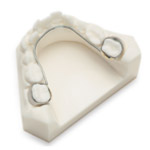 >A holding arch is placed around the first molars and is used to maintain space in the mouth. Patients who have prematurely lost baby teeth or patients with crowding and/or bite issues can often benefit from this appliance. Holding arches are often recommended as a patient is getting near to losing all their baby/primary teeth. Some baby teeth are actually larger than the adult tooth that will replace them. By placing a holding arch before the loss of the baby teeth, valuable space can be gained making treatment faster and easier! Patients wearing holding arches should avoid sticky foods.
>A holding arch is placed around the first molars and is used to maintain space in the mouth. Patients who have prematurely lost baby teeth or patients with crowding and/or bite issues can often benefit from this appliance. Holding arches are often recommended as a patient is getting near to losing all their baby/primary teeth. Some baby teeth are actually larger than the adult tooth that will replace them. By placing a holding arch before the loss of the baby teeth, valuable space can be gained making treatment faster and easier! Patients wearing holding arches should avoid sticky foods.Palatal Expanders
Palatal expanders work by stretching your mouth slightly, and remain in place for about 6 months. Most expanders must be turned, or activated, anywhere from 24-40 times during this period. The number of turns depends on the type of expander you’ve been given.Cemented palatal expander
 This appliance expands the upper jaw, creating more space for the teeth, and allows a better fit with the lower jaw. It must be worn and taken care of as directed by Dr. Kadar. Here is some information to help you achieve the best results. To Activate:
This appliance expands the upper jaw, creating more space for the teeth, and allows a better fit with the lower jaw. It must be worn and taken care of as directed by Dr. Kadar. Here is some information to help you achieve the best results. To Activate:- Turn the key once each day – at the same time each day – until you’re instructed to stop.
- Extend the metal swivel on the key, and place the end into the hole.
- Push towards the back of your mouth as far as you can.
- Do not stop or pull the key out until you see a new hole appear, and you can no longer push the key.
- If you miss your next scheduled appointment, do NOT turn the expander more than 24 turns.
- Pressure from the upper teeth to the temple area for about 5-30 minutes.
- A space may begin to form between the two upper front teeth. It typically closes after the final turn.
- Important note: Eat, talk, and swallow very slowly for the first few days. After about 3 days, you’ll feel much better, and after 7 days, you’ll be fully adjusted to your new appliance.You may notice increased salivation, because your mouth thinks that the expander is food! But this will also improve with time.
Removable palatal expander
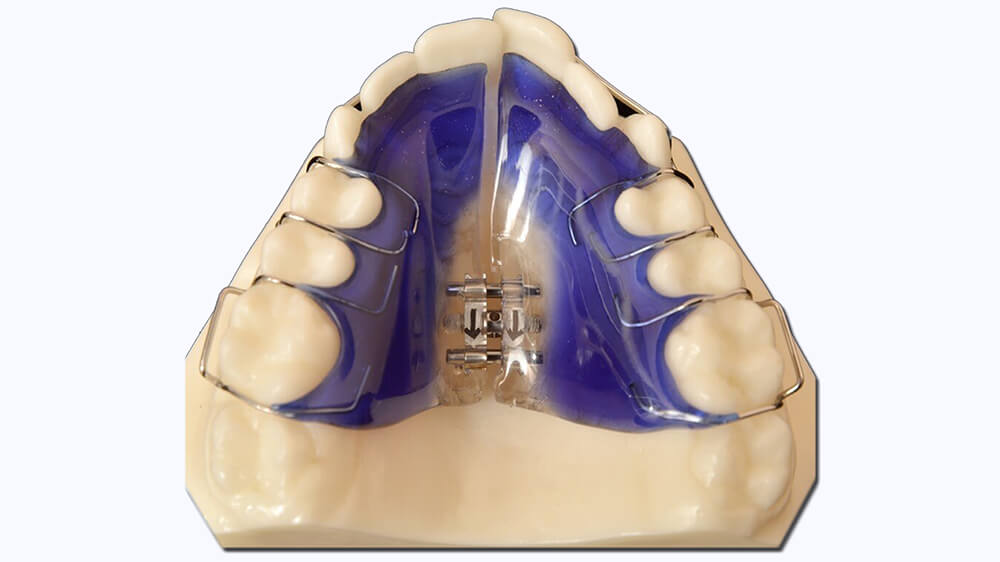 This appliance expands the upper jaw, creating more space for the teeth, and allows a better fit with the lower jaw. It must be worn and taken care of as directed by Dr. Kadar. Here is some information to help you achieve the best results. To activate, remove the expander from your mouth. Then:
This appliance expands the upper jaw, creating more space for the teeth, and allows a better fit with the lower jaw. It must be worn and taken care of as directed by Dr. Kadar. Here is some information to help you achieve the best results. To activate, remove the expander from your mouth. Then:- Turn the key once every 5 days – at the same time each day – until you’re instructed to stop.
- Extend the metal swivel on the key, and place the end into the hole.
- Push toward the direction of the arrow.
- Do not stop or pull the key out until you see the new hole appear, and you can no longer push the key.
- If you miss your next scheduled appointment, do NOT turn the expander more than 24 turns.
- Pressure from the upper teeth to the temple area for about 5-30 minutes
- A space may begin to form between the two upper front teeth. It typically closes after the final turn.
- Important note: Eat, talk, and swallow very slowly for the first few days. After about 3 days, you’ll feel much better, and after 7 days, you’ll be fully adjusted to your new appliance. You may notice increased salivation, because your mouth thinks that the expander is food! But this will also improve with time.
Herbst Appliance
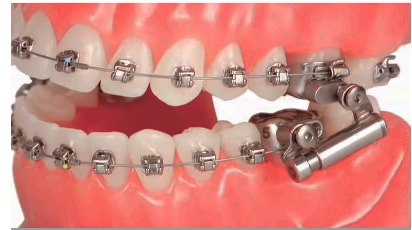 Affectionately known as the “shock absorber,” this is a bite-jumping device used to pull your lower jaw forward and, at the same time, push the upper jaw backward. It can also be designed to allow your upper arch to expand and help correct the front-to-back relationship between the upper and lower jaws. A rod and tube (that really does act like a shock absorber) connects your upper and lower jaws. This won’t interfere with opening and closing your mouth, but you may find moving your mouth from side-to-side a bit of a challenge. The Herbst appliance is normally worn for 12 months. To be effective, it must be worn and taken care of as directed by the Doctor. Caring for your Herbst appliance:
Affectionately known as the “shock absorber,” this is a bite-jumping device used to pull your lower jaw forward and, at the same time, push the upper jaw backward. It can also be designed to allow your upper arch to expand and help correct the front-to-back relationship between the upper and lower jaws. A rod and tube (that really does act like a shock absorber) connects your upper and lower jaws. This won’t interfere with opening and closing your mouth, but you may find moving your mouth from side-to-side a bit of a challenge. The Herbst appliance is normally worn for 12 months. To be effective, it must be worn and taken care of as directed by the Doctor. Caring for your Herbst appliance:- To chew easier, cut your food into small bites for the first few days.
- If you open your mouth too far and the appliance comes apart, just open a little wider to guide the appliance back together as you close your mouth.
- Sleep on your back to keep pressure off your cheeks.
- If a screw, or any part of the appliance comes loose, save the part and call us. It’s not necessarily to replace the screw immediately, since your muscles will hold your lower jaw in position for several days.
- You may feel irritation on the inside of your mouth, place a cotton roll along the cheek near the appliance at bedtime to lessen irritation and sores. (Eventually, these areas will toughen up)
- Tenderness in your teeth and some of your cheek muscles is normal, and should last only 3 to 7 days. Acetaminophen may help relieve these symptoms.
Tooth positioner
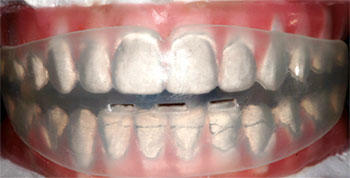 Like a retainer, a tooth positioner holds the teeth in their proper position and helps to settle the bite. It must be worn 24 hours a day, for at least the first 4 to 7 days. It is essential to exercise the teeth by clenching into the tooth positioner for 20 seconds, every 10-15 minutes. By doing this, there’s a very good chance your braces can be removed sooner. Caring for the tooth positioner:
Like a retainer, a tooth positioner holds the teeth in their proper position and helps to settle the bite. It must be worn 24 hours a day, for at least the first 4 to 7 days. It is essential to exercise the teeth by clenching into the tooth positioner for 20 seconds, every 10-15 minutes. By doing this, there’s a very good chance your braces can be removed sooner. Caring for the tooth positioner:- Floss everyday! Flossing is very important to maintain the health of your teeth and gums, especially while the positioner is in place.
- Store your positioner in its case, in a cool, safe place when it isn’t in your mouth. Heat can warp the positioner, resulting in a distorted fit.
- You may remove your positioner during meals, and when brushing. However, try to wear it as much as possible, 24 hours a day.
- Clean your positioner by brushing it with a small drop of toothpaste, then rinse with cold water.
- Call us if you have any questions about any of your appliances.
In an Emergency
What should I do if one of my wires comes loose and is poking into my cheek? What if one of my teeth gets knocked out? Or if something gets caught between my teeth? The answer – stay calm. Most problems with orthodontic treatment can be corrected easily at home. If you’re experiencing a problem, try these solutions first. If they don’t correct the problem, give us a call. In many cases, we can talk you through the solution right over the phone! If the office is not open, our 24-hour in-house answering service will help you.- Loose wire – You can reposition the wire into place with tweezers. If this is not possible, clip the wire with a pair of nail clippers or wire cutters behind the last tooth to which it is securely fastened. Wax it if you feel any discomfort.
- Knocked-Out Tooth – Call your family dentist as soon as possible. If possible, hold the tooth in your mouth, or store it in a cup of milk until you receive treatment. If dental treatment cannot be arranged within a reasonable time, gently replace the tooth in its socket – taking care to orient it correctly! – and go to a hospital emergency room.
- Poking wire – Simply push the poking wire down with a spoon or an eraser. If this is not possible, wax it. If discomfort persists, using a clean nail clipper or wire cutter, cut the wire closest to the next bracket in front of it. Notify our office the next business day so we can repair it.
- Lost tie wire or elastic tie – Notify us at your next appointment.
- Object Between Teeth – Try to remove the object by gently using dental floss. Do not use a sharp or pointed instrument. If you’re not successful, call us!
- Loose band or bracket – If the band or the bracket is still attached to the wire, leave it in place. Place wax on the broken area to make it comfortable. If the band or bracket comes out completely, wrap it up in tissue and give us a call during office hours.
- Soreness – This can be relieved by the use of warm salt water rinses and Tylenol or Ibuprofen for relief from discomfort. Call us during office hours if soreness persists for more than 3 days.
- Severe trauma, fractured teeth, bones or cuts to the mouth area requiring stitches – Call your dentist or go to the emergency room. Once the trauma has been treated, please notify our office.
- Appliance dangling or locking open – Please call 856-582-1400 and press #9, a Kadar team member will get back to you promptly.
It’s a Matter of Business
Scheduling & Appointments
So you got your Damon Braces™, Invisalign® or orthodontic appliance placed and working! Now what? You can leave the orthodontic stuff to Team Kadar. Your job is to schedule and keep your appointments so we can complete treatment the fastest way possible. At Kadar Orthodontics, we value your time, because we know that your life is busy. Did you know that our Doctor will personally examine your teeth each and every appointment? We are in the office Monday-Friday and have an after hours answering system. You can always reach us here on the web 24 hours a day and email your question when it is convenient for you! To keep your treatment progressing smoothly, we schedule most appointments on an 8-14 week cycle, with early morning and late afternoon maintenance appointments available. Did you know that 93% of our patients are seen within six minutes of their scheduled time? We constantly evaluate and revise our scheduling system to provide you with the best service during your orthodontic visits. We understand that your own schedule may be hectic. That’s why our automated system gives you a courtesy reminder call, and leaves a message if you’re not there. We also send reminder e-mails to those who prefer them. If you prefer to receive reminders by e-mail, please give us your e-mail address. You’ll receive a secure password so you can check your appointments online 24/7 and view your photos, x-rays, and account balances, as well! If you need to reschedule, please give us at least 48 hours’ notice, so that we can keep everyone’s treatment on schedule – including yours. We’ll try to give you the same time slot; however, the more popular appointment times may not be open for several weeks. Please make sure we receive any changes in your phone number so we can update our records. You can email our Scheduling Coordinator at schedule@https://gokadar.com or call the office 856-582-1400. And remember, Keep Smiling – even with those Braces on!Your Account & Insurance
When you come for an initial consultation, Dr. Kadar develops an individualized treatment plan for you. Thus, the orthodontic charges that are presented will be based on your specific needs. Our Treatment Coordinator reviews the total charges, insurance benefits (if applicable) and payment plan options. Our charges are comprehensive and include initial and progress photos, x-rays and models of your teeth. The fee includes all visits, including emergency care appointments, during observation and active treatment. Patients receive complimentary retainers at the conclusion of treatment.To make orthodontic treatment affordable to all of our patients, we offer several methods to fit your specific situation. Our payment plans include a cash discount for full payment and use of automatic monthly payments through your checking or credit card account. In addition, we work with several financing companies that provide low interest, no initial fee and extended term plans.If you have orthodontic insurance, we will let you know how your plan will effect the payment options provided. We also suggest you call the health plan directly to verify your coverage. When you call, ask for the dental claims department and provide the subscriber’s identification number, DOB, etc. Our goal is to be sure you receive all of your insurance reimbursement in a timely manner. We know that understanding insurance and payments plans, etc can be confusing. To help ease the process, Dr. Kadar has employed a full-time Financial Coordinator since 1999. With over 30 years of healthcare experience, she assists patients and parents with insurance reimbursement, flexible spending, credit and debit card billing, external financing and coupon payments. Payment Questions: call our Financial Coordinator at 856-582-1400 or email business@https://gokadar.com anytime day or night!
When treatment is over
 Everyone looks forward to the big day when the braces come off! It is the end of a lengthy commitment, and the culmination of all the effort invested by both the patient and the orthodontist. The final phase may last from 3 weeks to 6 months, and usually includes using rubber bands to help teeth and jaws achieve maximum fit. It is a crucial time when final adjustments determine ideal results and when attention to detail achieves your perfect smile and most comfortable bite. At your final appointment, a hygienist will remove the braces, polish tooth surfaces where the braces were attached, and make impressions for retainers, take photos and one final x-ray.
Everyone looks forward to the big day when the braces come off! It is the end of a lengthy commitment, and the culmination of all the effort invested by both the patient and the orthodontist. The final phase may last from 3 weeks to 6 months, and usually includes using rubber bands to help teeth and jaws achieve maximum fit. It is a crucial time when final adjustments determine ideal results and when attention to detail achieves your perfect smile and most comfortable bite. At your final appointment, a hygienist will remove the braces, polish tooth surfaces where the braces were attached, and make impressions for retainers, take photos and one final x-ray.You will leave the office with an appointment to return in a week to receive your retainer and you will do so with a big, bright, beautiful new smile!The retainer phase is simpler but every bit as important as the active treatment phase. The retainer is designed to prevent unwanted tooth movement and is custom fitted for your comfort. To guide your progress, our office will determine how you should wear it, how often and for how long. You will come back and be examined from time to time to make sure all is going well. All you have to do is follow some simple rules. Here are the types of retainers Dr. Kadar provides for his patients:
Clear retainer
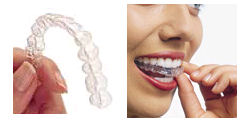 Most patients can wear a clear retainer. Designed to fit directly over teeth, it resembles a thin version of the moldable mouth guard, and is invisible to everyone but you. The retainer must be worn 24 hours a day for the first 14 days. After the full-time period is over, you’ll need to wear your retainer every night for about 10-12 hours, or until instructed otherwise by the Doctor. You’ll receive 2 sets of clear retainers. One is for daytime, and the other is for nighttime wear. Caring for your clear retainer:
Most patients can wear a clear retainer. Designed to fit directly over teeth, it resembles a thin version of the moldable mouth guard, and is invisible to everyone but you. The retainer must be worn 24 hours a day for the first 14 days. After the full-time period is over, you’ll need to wear your retainer every night for about 10-12 hours, or until instructed otherwise by the Doctor. You’ll receive 2 sets of clear retainers. One is for daytime, and the other is for nighttime wear. Caring for your clear retainer:- Wear as directed, except when eating or brushing your teeth
- Store in its case in a cool place. Heat can warp your retainer and as a result, won’t fit as well.
- Clean each night with a toothbrush and liquid soap – DO NOT USE TOOTHPASTE WHICH CAN DULL THE SHINE! Baking soda or a denture cleaner will treat tougher stains.
- Bring with you to every appointment, so we can see if they’re still fitting properly.
- Keep your models in a safe place! They’re needed to make replacement retainers, and may eliminate the need to make a new impression.
- Don’t drink sugary liquids while wearing clear retainers. The sugar won’t wash away, and it can cause tooth discoloration and decay!
- If a sore develops from a rough spot on the retainer, smooth it with a new nail file.
Active Clear Retainer
The Active Clear Retainer (ACR) moves your teeth into a better, more attractive position. To be effective, it must be worn and taken care of as directed by the Doctor. Your teeth will feel sore for about 3 days. This is a sign that they’re beginning to become your new and brighter smile. Take acetaminophen or ibuprofen to alleviate any discomfort. Caring for your ACR:- Brush or rinse your retainer daily. A denture cleaner (such as Efferdent) can be used once a week. DO NOT USE TOOTHPASTE WHICH CAN DULL THE SHINE
- If a sore develops from a rough spot on the retainer, smooth it with a new nail file.
- Don’t drink sugary liquids while wearing active retainers. The sugar won’t wash away, and it can cause tooth discoloration and decay!
- Store in its case in a cool place. Heat can warp your retainer and as a result, won’t fit as well.
- Keep your ACR away from pets – they love them even more than you do!
- Bring your ACR with you to each visit.
- Do NOT discard any ACRs. Store them as described above.
- If you lose your retainer or if it does not fit properly, call our office immediately.
Bonded retainer (also called Permanent retainer)
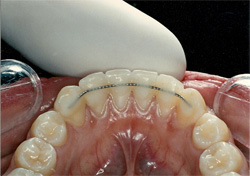 The bonded retainer prevents the recurrence of mild to severe crowding or spacing on the front teeth. It’s a thin wire that’s glued to the tongue-side of the front teeth, similar to the way braces are applied. Because of this, you can eat and brush your teeth without removing it! The bonded retainer can be worn for years, and removed at your request. However, it requires proper flossing and brushing techniques to help you maintain healthy teeth and gums. Caring for your bonded retainer:
The bonded retainer prevents the recurrence of mild to severe crowding or spacing on the front teeth. It’s a thin wire that’s glued to the tongue-side of the front teeth, similar to the way braces are applied. Because of this, you can eat and brush your teeth without removing it! The bonded retainer can be worn for years, and removed at your request. However, it requires proper flossing and brushing techniques to help you maintain healthy teeth and gums. Caring for your bonded retainer:- Remember to floss every day! Simply follow these instructions:
- Using a floss threader, feed the floss through the center of the hole.
- Starting directly at the gum line (under the wire), gently guide the threader between the teeth until you see the threader start to protrude out toward your tongue.
- Grab the threader and pull the floss between your teeth. Now you can floss down and around those teeth. Finally, pull the floss out.
- Repeat for all remaining teeth bonded to the retainer.
- Use your back-up. Use the clear retainer if your bonded retainer comes loose. Follow the care instructions for the clear retainer
- Keep your models in a safe place! They’re needed to make replacement retainers, and may eliminate the need to make a new impression.
Hawley Retainer
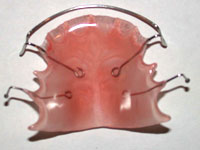 This retainer is designed with an acrylic piece that fits perfectly on the roof of your mouth, or under your tongue. Your teeth are held in position by a metal wire that runs along the front of the teeth from canine to canine. Hawley retainers keep spaces between teeth from reopening, and may need to be adjusted in the first few months to make sure they’re stabilized. Full-time wear is required at first, followed by nighttime wear as instructed by the Doctor. Caring for your Hawley retainer:
This retainer is designed with an acrylic piece that fits perfectly on the roof of your mouth, or under your tongue. Your teeth are held in position by a metal wire that runs along the front of the teeth from canine to canine. Hawley retainers keep spaces between teeth from reopening, and may need to be adjusted in the first few months to make sure they’re stabilized. Full-time wear is required at first, followed by nighttime wear as instructed by the Doctor. Caring for your Hawley retainer:- Wear as directed, except when eating or brushing your teeth.
- Store in its case in a cool place. Heat can warp your retainer and, as a result, won’t fit as well.
- Clean each night with a toothbrush and toothpaste. Baking soda or a denture cleaner will treat tougher stains.
- Bring with you to every appointment, so we can see if they’re still fitting properly.
- Keep your models in a safe place! They’re needed to make replacement retainers, and may eliminate the need to make a new impression.
- Avoid bending retainer wires – this could distort or even ruin the fit.

